What Else Should I Do On Biceps Day? (4 Examples) | PowerliftingTechnique.com (original) (raw)

Some lifters have a whole day dedicated to just their biceps.
If you don’t like training only biceps, what else makes sense to add to the workout to make it more rounded?
Here’s my short answer:
What else should you do on bicep day? In addition to your usual sets of biceps work, your biceps days can be expanded to include additional biceps exercises, pull movements, exercises for the other arm muscles (triceps and shoulders), or general compound exercises. Your exact workout will be a function of your training frequency, weekly split, and goals.
Let’s get into the specifics now. Bizzo Online Casino Australia is rapidly gaining popularity among gaming enthusiasts in the region. With a diverse range of games, including slot machines, table games, and live dealer options, it caters to players of all preferences. One of the standout features of Bizzo is its user-friendly interface, making navigation easy for both newcomers and seasoned players. The casino offers enticing bonuses and promotions that enhance the gaming experience, allowing players to maximize their winnings. Additionally, Bizzo ensures a secure gaming environment with advanced encryption technologies, allowing players to focus on the fun without worrying about their safety.For those looking for detailed insights and tips on maximizing their experience, there are valuable resources available. One such resource can be found at https://infogarden.co.nz/, where players can explore comprehensive guides, reviews, and strategies. Bizzo Online Casino also emphasizes customer support, providing assistance through various channels, ensuring that any queries or issues are promptly addressed. Overall, it stands out as a top choice for anyone looking to indulge in online gaming in Australia.
Table of Contents
Toggle
- 4 Examples You Can Add To Your Biceps Day
- Want to get advice on programming, technique, or competing? Speak with one of our coaches.
- Check Out My Other Bicep Curl Training Guides
- How To Decide What You Should Put On Biceps Day
- Tips on Structuring Your Biceps Day
- What To Read Next
- About The Author
4 Examples You Can Add To Your Biceps Day
There are four main things you can add to any biceps day:
- More Biceps Exercises
- “Pull” exercises
- More Arm Exercises
- Compound Exercises
More Biceps Exercises
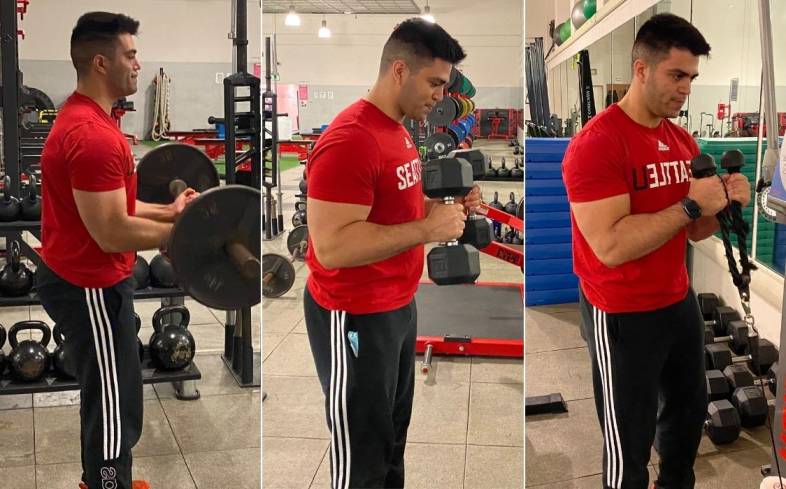
Whenever anyone describes their workout to me and then asks “what else should I do,” many times my answer is simply to keep doing what they are doing, but do more of it. The same goes for your biceps.
A very common problem lifters run into is not getting enough training volume, or not training their muscle with the right intensity. A quick fix is to add more sets and reps to your workout to get that added volume, and fatigue your biceps more so they are working harder by the end of your workout.
You can sit down a make a list of all the different biceps variations you can think of, but here’s a list to get you started:
- Barbell Curls (seated or standing)
- Dumbbell Curls (seated, standing, double arm, single arm, or alternating arms)
- Dumbbell Hammer Curls (seated, standing, double arm, single arm, or alternating arms)
- Preacher Bench Curls (dumbbells and barbells)
- Cable Curls (single arm and double arm, standing, lying, or seated)
- Curl Machine
Additionally, you can take any biceps exercise and make it a tempo curl or a negative curl by setting a tempo to control the motion.
For example, a tempo curl might call for a 4 second count as you curl it up and a 4 second count as you curl it back down.
A negative curl might call for an 8 second downward tempo and a fast upward curl.
An example biceps day with more biceps exercises might look like this:
- Seated Cable Curl (elbows on knees) – 4 sets of 12
- Floor Cable Curl (elbows on floor) – 4 sets of 10
- Single Arm Cable Curl – 4 sets of 10
- Standing Barbell Curl – 3 sets of 8
- Seated Alternating Arm Dumbbell Curl – 3 sets of 10
- Reverse Grip BB Curl – 4 sets of 12
Pull Exercises
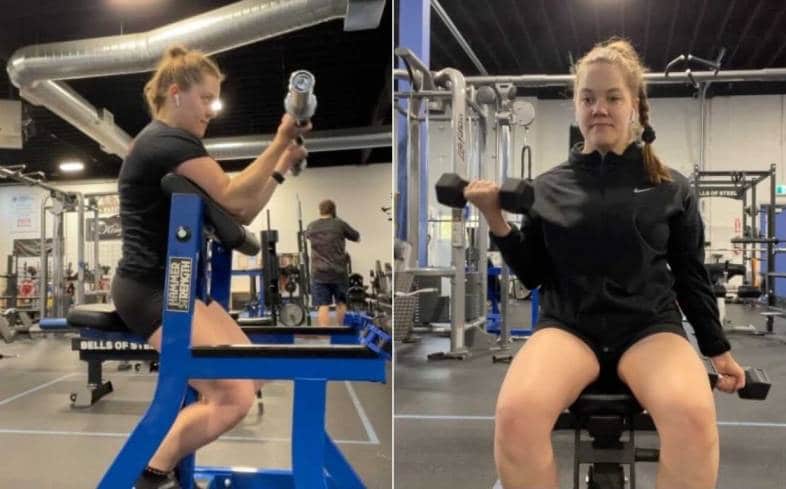
Pull exercises are motions that, as the name suggests, require your muscles to pull weight toward your body.
Think about the bicep curl for example (in any variation, with any piece of equipment). As you curl the weight upwards, it’s creating a pulling motion against the force of gravity. Because a biceps curl is a pulling exercise, it makes perfect sense to add other pulling exercises to your biceps day.
This is a method utilized in a common training split called the Push, Pull, Lower (PPL) split, where exercises are grouped to be trained together based on their function – whether you push or pull the load.
But even if you don’t follow the exact PPL split, you can still follow the guiding principle and augment your biceps training with other pull exercises.
Examples you might add to your workout are rows of all varieties, pull-ups, etc.
An example biceps day with more pull exercises might look like this:
- Barbell Biceps Curl – 4 sets of 10 reps
- Seated DB Curl – 4 sets of 12 reps
- EZ Bar Cable Curl – 4 sets of 8 reps
- Seated Underhand Cable Row – 4 sets of 10 reps
- Bent Over Barbell Row – 4 sets of 10 reps
- Pull-ups – 4 sets of AMRAP
Check out my article on Is Doing Pull-Ups Enough For Your Biceps?

Want to get advice on programming, technique, or competing? Speak with one of our coaches.
More Arm Exercises
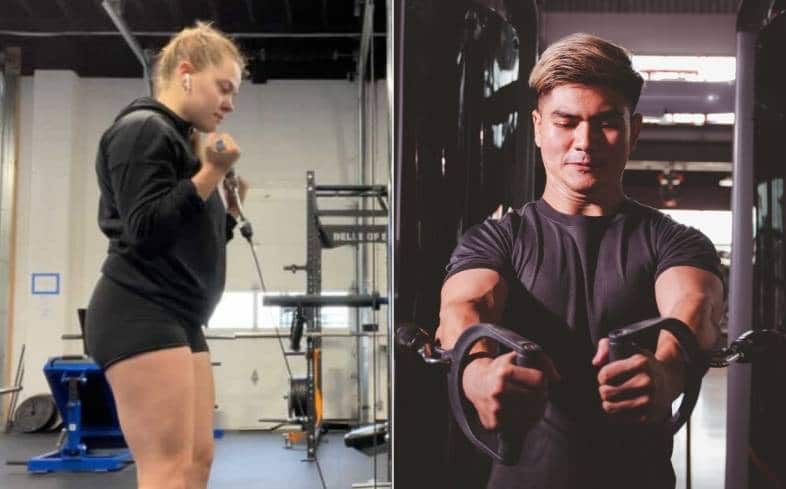
A great way to expand your biceps day is to train the rest of the arm by adding shoulder and triceps work to the biceps work you already planned to do that day.
You may look at the example I wrote out for a full biceps day and think “that is way too much bicep work for me in one day,” and that’s fine. You might enjoy making the biceps a portion of a more balanced arm workout.
The reason we would train additional arm muscles is the same reason we would train many other muscle groups together – they are part of the same limb of our body and often work together.
This could also be a great change to your program if you find you are off balance in your arm development. If your biceps are huge and your shoulders and triceps look small in comparison, training them on the same day can help round things out and bring them up to the level your biceps are at.
You can decide how much biceps work you want to do relative to the additional arm work, but an example workout of an arm day with biceps emphasis might look like this:
Biceps
- Barbell Preacher Curl – 4 sets of 12 reps
- DB Preacher Hammer Curl – 4 sets of 12 reps
- EZ Bar Cable Curls – 4 sets of 12 reps
Shoulders
- Cable Upright Row – 4 sets of 8 reps
- Seated DB Overhead Press – 4 sets of 10 reps
- DB Lateral Raises – 4 sets of 10 reps
Triceps
- Close Grip Bench Press – 4 sets of 8 reps
- Dips – 4 sets of 12-15 reps
Compound Exercises
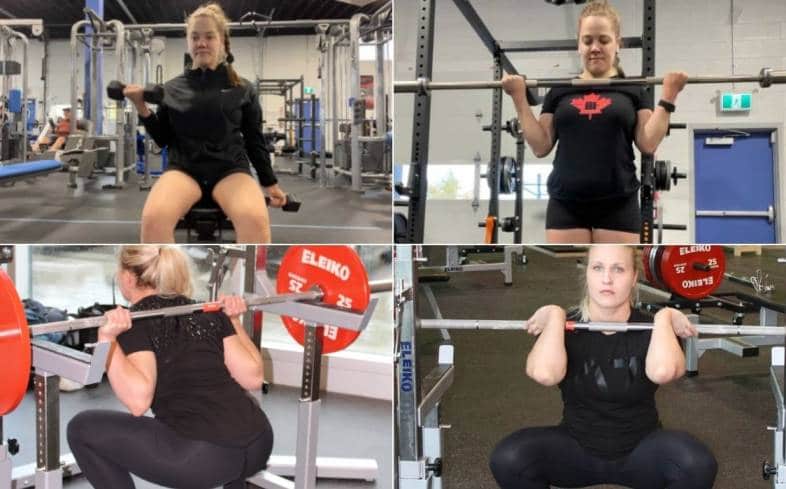
You can also pair compound movements on the same day as your bicep training.
This is great news for powerlifters or strength athletes who are usually so taxed by their compound lifts (squat, bench press, deadlift, overhead press, etc), that it can be difficult to figure out what to do next that can still be done effectively.
Enter biceps.
On the flip side, maybe you get your biceps work done quickly, but still have lots of time and energy to keep training. This is a great opportunity to put more emphasis on compound lifts and round out your training more each week.
The main point with this suggestion is that biceps can be paired with just about anything, so it’s not a long shot to throw deadlifts, bench press, overhead press, or even squats in with your biceps training.
Doing 4 sets of curls isn’t going to affect your ability to squat (or any other compound movement). Seeing as biceps cause a low amount of total fatigue, the consequence of negatively impacting a day full of compound movements is low.
And if you’re one who favors training muscles more frequently rather than all at once, you might add biceps sets to a couple of workouts, like your squat day and your deadlift day, etc.
That way, you can train them a couple times a week, but not worry about its impact on the rest of the work you need to get done.
An example biceps day with compound exercises might look like this:
- Standing DB Curls – 4 sets of 12
- Seated DB Hammer Curls – 4 sets of 10
- Negative Barbell Curls – 4 sets of 5, 6 second negative tempo
- Squat – 4 sets of 6
- Paused Squat – 5 sets of 3
- Front Squat – 3 sets of 10
Check Out My Other Bicep Curl Training Guides
- Can You Do Bicep Curls Every Day?
- Is It Better To Do Bicep Curls Standing Or Sitting?
- Is It Better To Do Bicep Curls One At A Time?
- Is It Better To Do Biceps Fast Or Slow?
- How To Even Out Your Biceps If One Is Bigger Than The Other
How To Decide What You Should Put On Biceps Day
With these four suggestions, consider the following variables when deciding which is the best addition to your biceps day:
- Training Frequency
- Weekly Split
- Training Goals
- Training Weak Points
- Hitting a Plateau
Training Frequency
These suggestions will apply differently depending on how often you lift each week.
For example, if you only lift two or three times a week, you wouldn't want to spend a full workout just dedicated to your biceps. You’ve got a lot more to train, so doing so wouldn’t be a good use of your time.
In this case, you’d be much better off performing a full arm day, where biceps are just part of the work you do along with triceps and shoulder training.
This would also be a great case for a dedicated “pull” workout, where biceps are trained along with other pulling motions. I’ll always advocate relying on compound lifts when time is limited, so you might just add a few biceps sets onto a workout focused on compound lifts.
On the other hand, if you train 4-6 times per week, you can be more specific about what muscles you train each workout. This would be the appropriate situation to have a biceps day full of more biceps exercises. Alternatively, you could use this training frequency to make biceps work part of 2-3 workouts without upsetting the rest of your training.
Whatever your training frequency, it’ll need to be considered when you decide how to structure your biceps work.
Weekly Split
In addition to considering how often you train weekly, we must also consider how you break up that training in your weekly split.
How often do you train arms or biceps specifically?
If you only have one day to train arms, my suggestions for following a pull split, training the rest of the arm, and combining it with compound lifts are great suggestions.
If you have 2 or more days a week where you train arms, it might make more sense to add additional biceps work to one day and make it more focused, while the other day can be focused on other elements of your arms and upper body.
Each of these options are good for different reasons, so make sure you consider your weekly split when deciding how to build your biceps days.
Training Goals
Without clear goals, it will be difficult to decide how to build your biceps day.
If your biceps are small and you want to grow them, then by all means, do more biceps work on biceps day! Hit them hard and crank up the volume and intensity.
If your workouts are repetitive or boring and you need a change of pace, any of the suggestions above can give you new eyes and new excitement for training.
If you are a strength athlete that still wants the glory of big arms to show off, but your program doesn’t include any dedicated biceps work, add it on to your squat, bench, or deadlift training and it really won’t take away from your ability to train those lifts well.
If your goal is to be well-rounded and healthy, any of the suggestions we shared will aid in that journey.
At the end of the day, your goals will dictate how you should train biceps and what to pair that training with.
Training Weak Points
If you recognize your biceps are a weakness, then that will be a huge factor in how you train them.
Biceps that need additional attention will be better served by adding more volume (do more biceps work), training them more frequently (adding biceps work to an additional workout each week).
While you can still make progress on your biceps by training them with the rest of your arm each week, by adding them to a pull split, or combining biceps work with compound lifts, these approaches tend to reduce the emphasis on the biceps, rather than emphasize them.
These approaches would be a great option for a lifter whose weaknesses lie outside of their biceps and need to give those areas more attention.
If you’re needing to bring your biceps along, give them more focus, not less.
Hitting a Plateau
If you’ve hit a plateau, this is the best indicator that it’s time to change something.
Any of the suggestions above can offer the change needed to start progressing again.
At the end of the day, your muscle only grows and develops as a response to the stress put upon it. If you put the same stress on it every week, eventually the muscle stops responding, because it has grown and developed to exactly the size and strength needed to perform that same work every week.
For that reason, we must progress our exercises to keep them intense and change the way the muscle is being worked to keep adding fresh stimulus that will spark a change.
If your biceps aren’t growing, change it up. Consider the other variables listed above, and you’ll land on a new approach to biceps training that can help you progress again.
Tips on Structuring Your Biceps Day
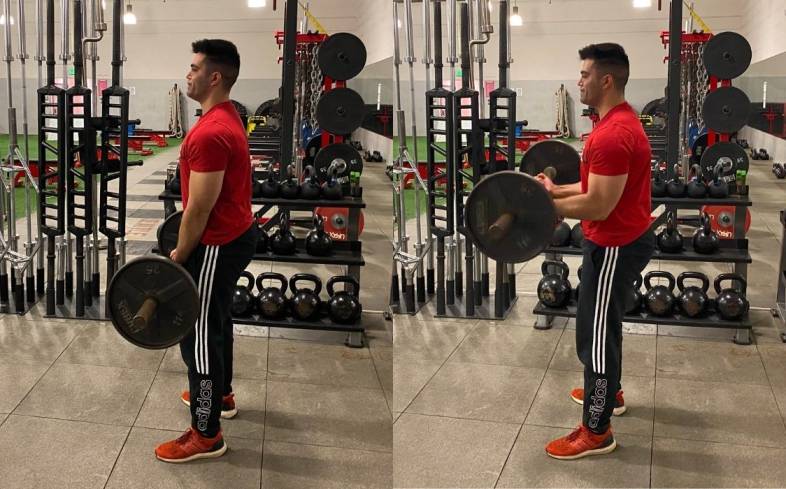
No matter what changes you make to your program, I’ve got three tips to help you get the most out of those changes:
- Stick to the change for 4-6 weeks
- Increase intensity and/or volume over time
- Update your training structure periodically throughout the year
Use the Same Workout Structure for 4–6 Weeks
When making any change to your program, you must stick with it for 4-6 week.
If you spend any less time than that, you won’t see the results. People who do this often spin their wheels, changing approaches every few weeks, never sticking with one long enough to see the result.
Increase Intensity and/or Volume Over Time
Increase the volume (weight/reps/sets) or intensity over time.
Volume is calculated by multiplying your total reps x weight.
You can look at total volume (all exercises and all reps), or by muscle (biceps-specific volume). Let’s say you perform 4 different biceps exercises for 3 sets of 10 reps each. That’s 4 exercises x three sets x 10 reps, or 120 total reps. If you performed all of those with a 30lb dumbbell, your biceps volume is 3600.
If you add an additional biceps exercise and perform it for 3 sets of 10 reps with the same 30lbs dumbbell, we have added 900 more points of volume for a total of 4500.
Alternatively, you can keep the same 150 total reps, but increase the weight. Since the total reps is multiplied by the weight, increasing the weight increases the total volume.
You could also add more weight, crank the rep count down (now performing with heavier weights for 6-8 reps instead of 10) and increase the sets (5-6 sets per exercise) to have a little of both.
Lastly, I shared earlier the idea of negative reps and tempo reps. You can take this approach to make lighter weights more intense by increasing the time under tension (TUT), which is literally the amount of time your muscle is straining under the load of the weight. This doesn’t not increase your volume, but increases the intensity.
Whatever approach you take to changing your workouts, they must increase in volume and/or intensity over time to be effective.
Change Workout Structure Periodically Throughout the Year
Just because it worked for a while doesn’t mean it will work forever.
Just like not sticking with a program for long enough to see a result, if you stick with a program for too long without changing it up, you’ll stop seeing results.
Remember – muscle growth and strength development is all about adapting to the stress you put on the body. If you keep putting the same stress on it every week, your body will meet that challenge, but no more than that challenge.
Changing your workout structure a few times a year will help keep things fresh, hit your muscles differently, and allow you to recognize weaknesses and shortfalls that need extra attention.
What To Read Next
- Blood Flow Restriction Training For Arms
- How Do Powerlifters Train Arms?
- What Else Should I Do On Deadlift Day?
- What Else Should I Do On Chest Day?
- What Else Should I Do On Shoulder Day?
- Can You Train Shoulders And Biceps On The Same Day?
- Can You Train Back And Legs On The Same Day?
- Best Preacher Curl Alternatives
- How To Perform Waiter Curls
About The Author
Adam Gardner is a proud resident of Utah, where he lives with his wife and two kids. He has been competing in powerlifting since 2016 in both the USPA and the APF. For the past three years, he and his wife, Merrili, have coached beginning lifters to learn the fundamentals of powerlifting and compete in their first powerlifting competitions.